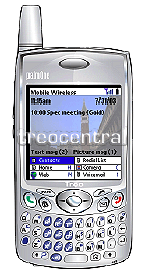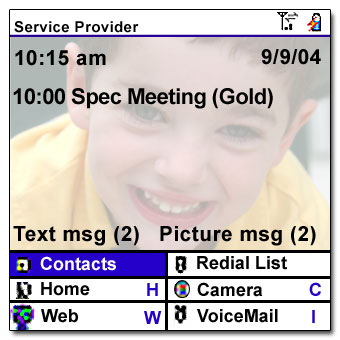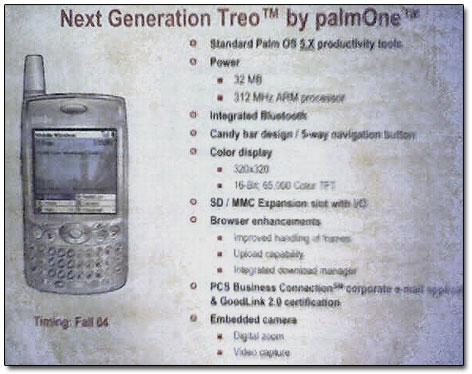
PalmOne has consistently said that they are interested in creating a family of Treos. They have yet to announce any additional products, but over the last few months TreoCentral has built up an idea of what one of the next generation Treos looks like. We have held off publishing this information as we attempted to gather further details about this next generation Treo. However, today an image featuring the new Treo was posted to our forums, and within hours many websites (engadget, palminfocenter) were linking to it. The cat was out of the bag. So without further ado, here is the full scoop on the 4th generation Treo.
We do not know the final name for this next generation Treo - nobody seems to know. There have been several outstanding rumors naming it the Treo 610. Still, we have also had reports that it will be named the Treo 660. As we could not confirm either name, we will stick to the codename of this next generation Treo: Ace.
Presenting the Treo Ace
The Treo Ace is a substantial revision to the Treo line. According to one source, "the cool factor is about the same between
Ace and the 600 as it was between the 600 and the 300. If anyone remembers their first experience with the 600, seeing and holding the Treo Ace gives the same
gasp impression that you got when you first held the 600."
To the top right is a rendering of the Treo Ace. While it looks similar to
the Treo 600, the new Treo is slightly smaller. The dimensions themselves did not change much - the Treo Ace is a couple millimeters thinner, shorter, and less wide.
However, we are told that the small changes in size are striking when you hold
it. The Treo Ace is also slightly rounder in shape than the Treo 600.
The Specifics:
- Transreflective 16 bit 320x320 screen - One individual who has handled the Treo Ace remarks that "The screen is just not to be believed - the screen is striking". The screen is slightly smaller in size as compared to the screen in the Treo 600. But the readability has been improved considerably with higher resolution, contrast, dot pitch. The 320x320 resolution of this screen is not to be overlooked. There are four times as many pixels on this new screen as compared to the older Treos. Surfing the web, reading pdfs, reading word documents will all require less horizontal scrolling. Add to that better image display capabilities for the camera, mapping, and gaming, and you have a much more useful device. This is the single most important improvement in the Treo Ace.
- Built in Bluetooth will allow the use of headsets, wireless syncing, and the ability for the Treo to act as a modem. TreoCentral has been told that it takes about a minute to setup Bluetooth for modem usage between the Treo Ace and a modern Mac, and then about 5 seconds every time after to connect.
- Smaller form factor (see above). Current cases may not fit the new Treo. The hotsync port remains the same however, so cables and chargers will continue to work.
- Curved Keyboard - The keyboard while similar to the Treo 600 has been curved into a upwards crescent shape. As the Treo Ace has a smaller form factor, PalmOne wanted to keep similar travel and
key spacing as it had on the current Treos. Curving the keyboard up allows for the device to be smaller, yet keeping the same keyboard feel. Lastly, the menu key at the bottom right of a Treo 600 has been replaced by a second shift key in the Treo Ace.
- Soft Buttons - Two new soft buttons above the four hard keys, beside the 5-way. These buttons will be context sensitive, akin to a modern
cell phones. For example, the left button will be speakerphone while in phone mode.
- Send/End Buttons - In the quest to make the Treo more like a phone, there will be Red and Green Send and End keys. The leftmost hard button will double as a green send key, where the rightmost hard button will act as a red end key.
- 1.3 MP Camera with digital zoom, built in video capture capability.
- 312 Mhz processor
- 32 MB RAM - Although it is unknown how much of this will be accessible to the user. 32 MB is pretty small for such an expensive PDA. PalmOne may have overbought 32 MB chips, and could be stuck in a long term contract with its memory supplier, forcing it to use these 32 MB chips, and not a higher capacity 64 MB chip.
- Palm OS 5.4 (Garnet)
- SDIO/MMC slot - The Treo Ace may or may not be able to supply enough power for a Wifi SD card.
Technically it might only be possible to use such a card if the cellular radio
was turned off, so it is unlikely that PalmOne would support it.
- New browser that can display frames and upload files. It also has an integrated download manager. As the screen is now high resolution, browsing the web will be a much better experience than with the current Treos, as four times as much "webpage" can be displayed.

- Home Screen - As pictured in our fullscale (that's 320x320 folks!) mockup at right, the home screen has been replaced by a "Today" Screen, akin to a Pocket PC's main screen. From here one will be able to view appointments, dial numbers, and launch applications. Message Events such as new mail, new text messages, or new voicemail will also be displayed here, along with date and time. The background is customizable.
The Treo Ace is scheduled to ship in Fall 2004. But depending on how development, and the production rampup goes, this could be as early as July or as late as Christmas 2004. We have not received any details on
pricing or on the official availability of the device..
The Treo Ace will eventually be sold through all of PalmOne's carrier partners, both CDMA and GSM. Sprint, most likely, will be launching the CDMA version, and AT&T will possibly launch the GSM version. Sprint recently announced their plans for EVDO technology. On the GSM side, Cingular (New owner of AT&T) has launched its high speed EDGE technology. It is unknown if the Treo Ace will support either of these next generation data standards.
It is interesting to note that the specifications of the Treo Ace are very similar to the recently launched Zire 72. The Zire 72 has an Intel PXA270 312 Mhz Xscale processor, 32 MB RAM, built in bluetooth, a 320x320 16 bit screen, and a built in 1.2 megapixel camera. But, while similar, the architectures are most likely very different. Handspring engineers for the most part designed the Treo Ace, while the Zire 72 is a carryover from Palm employees. The two groups of engineers most likely designed things very differently, and it will probably be another revision before we see designs that go between Zire, Tungsten, and Treo lines.
Lastly, due to a recent new rule (pdf) from the FCC, it is much easier for companies to request that their entire application for FCC certification be held confidential until the products public release. Therefore, it is unlikely that we will see an FCC leak of external photos, internal photos, or user manuals of the Treo Ace, before PalmOne announces it. The FCC's OET previously leaked information on the Treo 600, Treo 300, and Treo 180.
As the release of the Treo Ace is several many months away, these
specifications are likely to change. We do not recommend that you base any
purchasing decisions on the information reported above, until confirmed by
palmOne.
